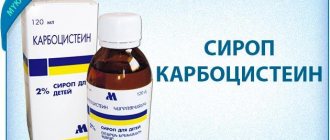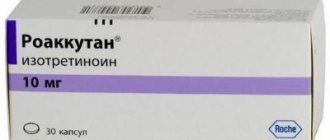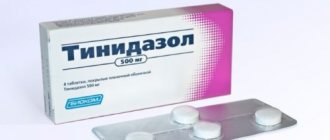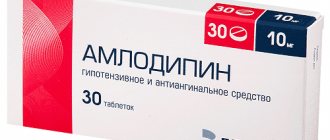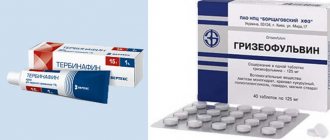pharmachologic effect
Bronchodilator, phosphodiesterase inhibitor (PDE).
It is the ethylenediamine salt of theophylline (which facilitates solubility and increases absorption). It has a bronchodilator effect, apparently due to a direct relaxing effect on the smooth muscles of the respiratory tract and blood vessels of the lungs. It is believed that this effect is caused by selective inhibition of the activity of specific PDEs, which leads to an increase in the intracellular concentration of cAMP. The results of in vitro experimental studies show that the main role appears to be played by type III and IV isoenzymes. Suppression of the activity of these isoenzymes may also cause some side effects of aminophylline (theophylline), including. vomiting, arterial hypotension and tachycardia. Blocks adenosine (purine) receptors, which may be one of the factors affecting the bronchi. Reduces airway hyperresponsiveness associated with the late phase response caused by inhaled allergens through an unknown mechanism that is not due to PDE inhibition or blockade of adenosine. There are reports that aminophylline increases the number and activity of T-suppressor cells in peripheral blood.
Increases mucociliary clearance, stimulates contraction of the diaphragm, improves the function of the respiratory and intercostal muscles, stimulates the respiratory center, increases its sensitivity to carbon dioxide and improves alveolar ventilation, which ultimately leads to a decrease in the severity and frequency of apnea episodes. By normalizing respiratory function, it helps saturate the blood with oxygen and reduce the concentration of carbon dioxide. Strengthens ventilation of the lungs in conditions of hypokalemia.
It has a stimulating effect on the activity of the heart, increases strength and heart rate, increases coronary blood flow and increases the myocardial oxygen demand. Reduces the tone of blood vessels (mainly those of the brain, skin and kidneys). It has a peripheral venodilating effect, reduces pulmonary vascular resistance, and lowers pressure in the pulmonary circulation. Increases renal blood flow and has a moderate diuretic effect. Expands extrahepatic bile ducts. Stabilizes mast cell membranes, inhibits the release of mediators of allergic reactions. Inhibits platelet aggregation (suppresses platelet activating factor and PgE2α), increases the resistance of red blood cells to deformation (improves the rheological properties of blood), reduces thrombus formation and normalizes microcirculation. It has a tocolytic effect, increases the acidity of gastric juice. In high doses it has an epileptogenic effect.
Instructions:
Clinical and pharmacological group
12.004 (Bronchodilator - phosphodiesterase inhibitor)
pharmachologic effect
Bronchodilator, PDE inhibitor. It is the ethylenediamine salt of theophylline (which facilitates solubility and increases absorption). It has a bronchodilator effect, apparently due to a direct relaxing effect on the smooth muscles of the respiratory tract and blood vessels of the lungs. It is believed that this effect is caused by selective inhibition of the activity of specific PDEs, which leads to an increase in the intracellular concentration of cAMP. The results of in vitro experimental studies show that the main role appears to be played by type III and IV isoenzymes. Suppression of the activity of these isoenzymes may also cause some side effects of aminophylline (theophylline), including. vomiting, arterial hypotension and tachycardia. Blocks adenosine (purine) receptors, which may be one of the factors affecting the bronchi.
Reduces airway hyperresponsiveness associated with the late phase response caused by inhaled allergens through an unknown mechanism that is not due to PDE inhibition or blockade of adenosine. There are reports that aminophylline increases the number and activity of T-suppressor cells in peripheral blood.
Increases mucociliary clearance, stimulates contraction of the diaphragm, improves the function of the respiratory and intercostal muscles, stimulates the respiratory center, increases its sensitivity to carbon dioxide and improves alveolar ventilation, which ultimately leads to a decrease in the severity and frequency of apnea episodes. By normalizing respiratory function, it helps saturate the blood with oxygen and reduce the concentration of carbon dioxide. Strengthens ventilation of the lungs in conditions of hypokalemia.
It has a stimulating effect on the activity of the heart, increases strength and heart rate, increases coronary blood flow and increases the myocardial oxygen demand. Reduces the tone of blood vessels (mainly those of the brain, skin and kidneys). It has a peripheral venodilating effect, reduces pulmonary vascular resistance, and lowers pressure in the pulmonary circulation. Increases renal blood flow and has a moderate diuretic effect. Expands extrahepatic bile ducts. Stabilizes mast cell membranes, inhibits the release of mediators of allergic reactions. Inhibits platelet aggregation (suppresses platelet activating factor and PgE2α), increases the resistance of red blood cells to deformation (improves the rheological properties of blood), reduces thrombus formation and normalizes microcirculation. It has a tocolytic effect, increases the acidity of gastric juice. In high doses it has an epileptogenic effect.
Pharmacokinetics
In the body, aminophylline is metabolized at physiological pH values to release free theophylline. Bronchodilating properties appear at plasma theophylline concentrations of 10-20 mcg/ml. Concentrations above 20 mg/ml are toxic. The stimulating effect on the respiratory center is realized at a lower concentration - 5-10 mcg/ml.
Theophylline binding to plasma proteins is approximately 40%; in newborns, as well as in adults with diseases, binding decreases. Plasma protein binding in adults is about 60%, in newborns - 36%, in patients with liver cirrhosis - 36%. Penetrates the placental barrier (the concentration in the fetal blood serum is slightly higher than in the maternal serum). Excreted in breast milk.
Theophylline is metabolized in the liver with the participation of several cytochrome P450 isoenzymes, the most important of which is CYP1A2. During metabolism, 1,3-dimethyluric acid, 1-methyluric acid and 3-methylxanthine are formed. These metabolites are excreted in the urine. 10% is excreted unchanged in adults. In newborns, a significant part is excreted in the form of caffeine (due to the immaturity of the pathways for its further metabolism), unchanged - 50%.
Significant individual differences in the rate of hepatic metabolism of theophylline are the cause of pronounced variability in clearance values, plasma concentrations, and half-life. Hepatic metabolism is influenced by factors such as age, addiction to tobacco smoking, diet, diseases, and concurrent drug therapy.
T1/2 of theophylline in non-smoking patients with bronchial asthma practically without pathological changes in other organs and systems is 6-12 hours, in smokers - 4-5 hours, in children - 1-5 hours, in newborns and premature babies - 10- 45 hours
T1/2 of theophylline increases in the elderly and in patients with heart failure or liver disease.
Clearance decreases with heart failure, liver dysfunction, chronic alcoholism, pulmonary edema, chronic obstructive pulmonary disease.
Ethylenediamine does not affect the pharmacokinetics of theophylline.
Dosage
Individual, depending on the indications, age, clinical situation, route and schedule of administration, nicotine addiction.
Drug interactions
When used simultaneously with sympathomimetics, a mutual enhancement of action occurs; with beta-blockers and lithium preparations - the effect is mutually reduced. The intensity of action of aminophylline may decrease (due to an increase in its clearance) when used simultaneously with phenobarbital, rifampicin, isoniazid, carbamazepine, sulfinpyrazone, phenytoin, as well as in smokers.
The intensity of action of aminophylline may increase (due to a decrease in its clearance) when used simultaneously with macrolide antibiotics, lincomycin, quinolones, allopurinol, beta-blockers, cimetidine, disulfiram, fluvoxamine, hormonal contraceptives for oral administration, isoprenaline, viloxazine and when vaccinated against flu
Xanthine derivatives may potentiate hypokalemia caused by the action of β2-adrenergic receptor stimulants, corticosteroids and diuretics.
Antidiarrheal drugs and enterosorbents reduce the absorption of aminophylline.
Pharmaceutically incompatible with acid solutions.
Use during pregnancy and lactation
Theophylline penetrates the placental barrier. The use of aminophylline during pregnancy may result in potentially dangerous concentrations of theophylline and caffeine in the blood plasma of the newborn. Newborns whose mothers received aminophylline during pregnancy (especially in the third trimester) require medical supervision to monitor possible symptoms of theophylline intoxication.
Theophylline is excreted in breast milk. When using aminophylline in a nursing mother during lactation, irritability may occur in the child.
Thus, the use of aminophylline during pregnancy and lactation (breastfeeding) is possible in cases where the expected benefit of therapy for the mother outweighs the potential risk for the fetus or child.
Side effects
From the central nervous system: dizziness, sleep disturbances, anxiety, tremor, convulsions.
From the cardiovascular system: palpitations, heart rhythm disturbances; with rapid intravenous administration - the appearance of pain in the heart, decreased blood pressure, tachycardia (including in the fetus when taken in the third trimester of pregnancy), arrhythmias, decreased blood pressure, cardialgia, increased frequency of angina attacks.
From the digestive system: nausea, vomiting, gastroesophageal reflux, heartburn, exacerbation of peptic ulcer, diarrhea; with prolonged ingestion - anorexia.
From the urinary system: albuminuria, hematuria.
Allergic reactions: skin rash, itching, fever.
Metabolic disorders: rarely - hypoglycemia.
Local reactions: compaction, hyperemia, pain at the injection site; when used rectally, irritation of the rectal mucosa, proctitis.
Other: chest pain, tachypnea, flushing, albuminuria, hematuria, hypoglycemia, increased diuresis, increased sweating.
Indications
For parenteral use: status asthmaticus (additional therapy), neonatal apnea, ischemic cerebrovascular accident (as part of combination therapy), left ventricular failure with bronchospasm and Cheyne-Stokes type breathing disorder, edematous syndrome of renal origin (as part of complex therapy) ; acute and chronic heart failure (as part of combination therapy).
For oral administration: broncho-obstructive syndrome of various origins (including bronchial asthma, COPD, including emphysema, chronic obstructive bronchitis), hypertension in the pulmonary circulation, cor pulmonale, sleep apnea; acute and chronic heart failure (as part of combination therapy).
Contraindications
Severe arterial hyper- or hypotension, tachyarrhythmias, peptic ulcer of the stomach and duodenum in the acute phase, hyperacid gastritis, severe dysfunction of the liver and/or kidneys, epilepsy, hemorrhagic stroke, hemorrhage in the retina, simultaneous use with ephedrine in children, childhood (up to 3 years, for prolonged oral forms - up to 12 years), hypersensitivity to aminophylline and theophylline.
special instructions
Use with caution in severe coronary insufficiency (acute phase of myocardial infarction, angina pectoris), widespread atherosclerosis, hypertrophic obstructive cardiomyopathy, frequent ventricular extrasystoles, increased convulsive readiness, liver and/or renal failure, gastric and duodenal ulcers (history), with recent bleeding from the gastrointestinal tract, uncontrolled hypothyroidism (possibility of cumulation) or thyrotoxicosis, with prolonged hyperthermia, gastroesophageal reflux, prostatic hypertrophy, in elderly patients, in children (especially orally).
Correction of the aminophylline dosage regimen may be required for heart failure, liver dysfunction, chronic alcoholism, fever, and acute respiratory infections.
In elderly patients, a dose reduction may be required.
When replacing the used dosage form of aminophylline with another, clinical observation and monitoring of the concentration of theophylline in the blood plasma is necessary.
Aminophylline is not used simultaneously with other xanthine derivatives. During the treatment period, you should avoid eating foods containing xanthine derivatives (strong coffee, tea).
Use with caution simultaneously with anticoagulants, with other theophylline or purine derivatives.
Concomitant use with beta-blockers should be avoided.
Aminophylline should not be used simultaneously with glucose solution.
Do not use rectally in children.
Use for renal impairment
Use with caution in case of renal failure.
Use for liver dysfunction
Use with caution in case of liver failure.
Preparations containing AMINOPHYLLINE
• EUPHYLLINE solution for intravenous administration 120 mg/5 ml: amp. 5 and 10 pcs. • EUPHYLLINE tab. 150 mg: 30 pcs. • EUPHYLLINE tab. 150 mg: 30 pcs. • EUPHYLLINE solution for intravenous administration 240 mg/10 ml: amp. 10, 100, 200 or 300 pcs. • EUPHYLLINE solution for intravenous administration 240 mg/10 ml: amp. 10 pieces. • EUPHYLLINE tab. 150 mg: 30 pcs. • EUPHYLLINE tab. 150 mg: 10, 20 or 30 pcs. • EUPHYLLINE solution for intravenous administration 120 mg/5 ml: amp. 5, 10 or 20 pcs. • EUPHYLLINE-UBF tab. 150 mg: 10, 20, 25, 30, 40 or 50 pcs. • EUPHYLLINE solution for intravenous administration 120 mg/5 ml: amp. 10, 100, 200 or 300 pcs. • EUPHYLLINE solution for intramuscular administration 240 mg/1 ml: amp. 10 pieces. • EUPHYLLINE tab. 150 mg: 10, 15, 20, 30, 40, 45, 50, 60, 75 or 100 pcs. • EUPHYLLINE tab. 150 mg: 30 pcs. • AMINOPHYLLINE-ESKOM solution for intravenous administration 240 mg/10 ml: amp. 5, 10 or 20 pcs. • EUPHYLLINE solution for intravenous administration 120 mg/5 ml: amp. 5 or 10 pcs. • EUPHYLLINE solution for intravenous administration 240 mg/10 ml: amp. 5 or 10 pcs. • EUPHYLLINE solution for intravenous administration 2.4% 240 mg/10 ml: amp. 5, 10 or 20 pcs. • EUPHYLLINE solution for intravenous administration 240 mg/10 ml: amp. 5, 10 or 20 pcs. • EUPHYLLINE tab. 150 mg: 10, 20, 25, 30, 40, 50, 60, 75, 80, 100, 125 or 3132 pcs. • EUPHYLLINE solution for intravenous administration 120 mg/5 ml: amp. 10 pieces. • EUPHYLLINE solution for intravenous administration 240 mg/10 ml: amp. 10 pieces. • EUPHYLLINE tab. 150 mg: 30 pcs. • EUPHYLLINE tab. 150 mg: 30 pcs. • EUPHYLLINE solution for intravenous administration 2.4% 120 mg/5 ml: amp. 5, 10 or 20 pcs. • EUPHYLLINE solution for intravenous administration 240 mg/10 ml: amp. 5 or 10 pcs. • EUPHYLLINE solution for intravenous administration 120 mg/5 ml: amp. 5 or 10 pcs. • EUPHYLLINE tab. 150 mg: 10, 20 or 30 pcs. • EUPHYLLINE solution for intravenous administration 2.4% 120 mg/5 ml: amp. 5, 10 or 20 pcs. • EUPHYLLINE solution for intravenous administration 120 mg/5 ml: amp. 10 pieces. • EUPHYLLINE solution for intravenous administration 240 mg/10 ml: amp. 10 pieces. • EUPHYLLINE tab. 150 mg: 10, 20, 30, 50 or 100 pcs. • EUPHYLLINE solution for intravenous administration 120 mg/5 ml: amp. 10 pieces. • AMINOPHYLLINE-ESKOM solution for intravenous administration 120 mg/5 ml: amp. 5, 10 or 20 pcs. • EUPHYLLINE solution for intravenous administration 240 mg/10 ml: amp. 5 and 10 pcs. • EUPHYLLINE solution for intravenous administration 2.4% 240 mg/10 ml: amp. 5, 10 or 20 pcs.
Pharmacokinetics
In the body, aminophylline is metabolized at physiological pH values to release free theophylline. Bronchodilating properties appear at plasma theophylline concentrations of 10-20 mcg/ml. Concentrations above 20 mg/ml are toxic. The stimulating effect on the respiratory center is realized at a lower concentration - 5-10 mcg/ml.
Theophylline binding to plasma proteins is approximately 40%; in newborns, as well as in adults with diseases, binding decreases. Plasma protein binding in adults is about 60%, in newborns - 36%, in patients with liver cirrhosis - 36%. Penetrates the placental barrier (the concentration in the fetal blood serum is slightly higher than in the maternal serum). Excreted in breast milk.
Theophylline is metabolized in the liver with the participation of several cytochrome P450 isoenzymes, the most important of which is CYP1A2. During metabolism, 1,3-dimethyluric acid, 1-methyluric acid and 3-methylxanthine are formed. These metabolites are excreted in the urine. 10% is excreted unchanged in adults. In newborns, a significant part is excreted in the form of caffeine (due to the immaturity of the pathways for its further metabolism), unchanged - 50%.
Significant individual differences in the rate of hepatic metabolism of theophylline are the cause of pronounced variability in clearance values, plasma concentrations, and half-life. Hepatic metabolism is influenced by factors such as age, addiction to tobacco smoking, diet, diseases, and concurrent drug therapy.
T1/2 of theophylline in non-smoking patients with bronchial asthma practically without pathological changes in other organs and systems is 6-12 hours, in smokers - 4-5 hours, in children - 1-5 hours, in newborns and premature babies - 10- 45 hours
T1/2 of theophylline increases in the elderly and in patients with heart failure or liver disease.
Clearance decreases with heart failure, liver dysfunction, chronic alcoholism, pulmonary edema, chronic obstructive pulmonary disease.
Ethylenediamine does not affect the pharmacokinetics of theophylline.
Interaction
When used together with sympathomimetic drugs , mutual activation of the pharmacological action occurs. lithium preparations and beta-blockers , the effect, on the contrary, is mutually weakened.
The intensity of the effect of Aminophylline decreases when used simultaneously with Rifampicin, Phenobarbital, Isoniazid, Sulfinpyrazone, Carbamazepine, Phenytoin , as well as in smokers.
The potency of Aminophylline may be increased when used simultaneously with L- incomycin, quinolones, macrolides, Allopurinol, Cimetidine, beta-blockers, isoprenaline, fluvoxamine, Disulfiram, oral contraceptives , B -iloxazine and with influenza vaccination.
Xanthine derivatives potentiate hypokalemia caused by the action of corticosteroids, beta-2 adrenergic agonists and diuretics .
Antidiarrheals and enterosorbents reduce the absorption of Aminophylline.
Indications
For parenteral use: status asthmaticus (additional therapy), neonatal apnea, ischemic cerebrovascular accident (as part of combination therapy), left ventricular failure with bronchospasm and Cheyne-Stokes type breathing disorder, edematous syndrome of renal origin (as part of complex therapy) ; acute and chronic heart failure (as part of combination therapy).
For oral administration: broncho-obstructive syndrome of various origins (including bronchial asthma, COPD, including emphysema, chronic obstructive bronchitis), hypertension in the pulmonary circulation, cor pulmonale, sleep apnea; acute and chronic heart failure (as part of combination therapy).
Aminophylline
Active substance:
Aminophylline*
Pharmgroup:
Adenosinergic drugs
Analogs for the active substance:Aminophylline-Eskom Eufillin Eufillin-Darnitsa | Application area:Allergic respiratory diseases Allergic lung diseases Secondary pulmonary hypertension Hypertension of the pulmonary circulation Diseases accompanied by bronchospastic syndrome Ischemic stroke Interstitial emphysema Infectious-allergic asthma Infectious-allergic bronchial asthma Ischemic brain disease Ischemic brain lesions Ischemic stroke Ischemic stroke and its consequences Ischemic cerebral stroke Ischemic cerebrovascular accident Ischemic brain damage Ischemic brain damage Ischemic condition Cerebral ischemia Pulmonary hypertension Pulmonary heart failure Pulmonary heart Exacerbation of chronic heart failure Reversible bronchospasm Obstructive pulmonary emphysema Dyspnea in acute heart failure Acute brain hypoxia Acute heart failure Acute cardiovascular failure Acute cerebral ischemia Acute ischemic cerebrovascular accident Acute cerebral infarction Acute ischemic stroke Acute period of ischemic stroke Focal cerebral ischemia Previous ischemic stroke Persistent atopic bronchial asthma Repeated stroke Heart failure due to intoxication Heart failure due to infections Acute heart failure Cardiac dyspnea Cardiopulmonary failure Morgagni-Adams-Stokes syndrome Spasmodic cough Chronic cerebral ischemia Chronic pulmonary heart failure Chronic myocardial failure Chronic obstructive pulmonary emphysema Chronic emphysema Chronic lung diseases Chronic obstructive pulmonary diseases Chronic cor pulmonale Cerebrovascular stroke Eisenmenger syndrome Embolic stroke Emphysema |
Side effect
From the side of the central nervous system:
dizziness, sleep disturbances, anxiety, tremors, convulsions.
From the cardiovascular system:
palpitations, heart rhythm disturbances; with rapid intravenous administration - the appearance of pain in the heart, decreased blood pressure, tachycardia (including in the fetus when taken in the third trimester of pregnancy), arrhythmias, decreased blood pressure, cardialgia, increased frequency of angina attacks.
From the digestive system:
nausea, vomiting, gastroesophageal reflux, heartburn, exacerbation of peptic ulcer, diarrhea; with prolonged ingestion - anorexia.
From the urinary system:
albuminuria, hematuria.
Allergic reactions:
skin rash, itching, fever.
From the side of metabolism:
rarely - hypoglycemia.
Local reactions:
compaction, hyperemia, pain at the injection site; when used rectally, irritation of the rectal mucosa, proctitis.
Other:
chest pain, tachypnea, flushing, albuminuria, hematuria, hypoglycemia, increased diuresis, increased sweating.
Use during pregnancy and breastfeeding
Theophylline penetrates the placental barrier. The use of aminophylline during pregnancy may result in potentially dangerous concentrations of theophylline and caffeine in the blood plasma of the newborn. Newborns whose mothers received aminophylline during pregnancy (especially in the third trimester) require medical supervision to monitor possible symptoms of theophylline intoxication.
Theophylline is excreted in breast milk. When using aminophylline in a nursing mother during lactation, irritability may occur in the child.
Thus, the use of aminophylline during pregnancy and lactation (breastfeeding) is possible in cases where the expected benefit of therapy for the mother outweighs the potential risk for the fetus or child.
special instructions
Use with caution in severe coronary insufficiency (acute phase of myocardial infarction, angina pectoris), widespread atherosclerosis, hypertrophic obstructive cardiomyopathy, frequent ventricular extrasystoles, increased convulsive readiness, liver and/or renal failure, gastric and duodenal ulcers (history), with recent bleeding from the gastrointestinal tract, uncontrolled hypothyroidism (possibility of cumulation) or thyrotoxicosis, with prolonged hyperthermia, gastroesophageal reflux, prostatic hypertrophy, in elderly patients, in children (especially orally).
Correction of the aminophylline dosage regimen may be required for heart failure, liver dysfunction, chronic alcoholism, fever, and acute respiratory infections.
In elderly patients, a dose reduction may be required.
When replacing the used dosage form of aminophylline with another, clinical observation and monitoring of the concentration of theophylline in the blood plasma is necessary.
Aminophylline is not used simultaneously with other xanthine derivatives. During the treatment period, you should avoid eating foods containing xanthine derivatives (strong coffee, tea).
Use with caution simultaneously with anticoagulants, with other theophylline or purine derivatives.
Concomitant use with beta-blockers should be avoided.
Aminophylline should not be used simultaneously with glucose solution.
Do not use rectally in children.
Contraindications
Severe arterial hyper- or hypotension , gastric or duodenal ulcer, tachyarrhythmias , severe liver or kidney damage, hyperacid gastritis, epilepsy , retinal hemorrhage, hemorrhagic stroke , combined use with ephedrine in children, age up to 3 years, for extended oral forms, limitation by age up to 12 years, sensitization to aminophylline and theophylline.
